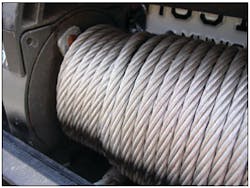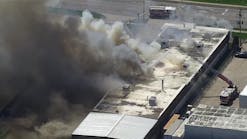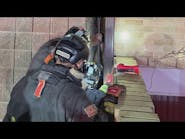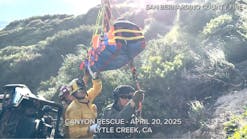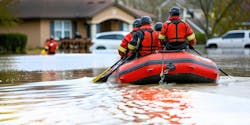This article could actually be titled “Things You Probably Don’t Know About Winches.” Each of the items listed is an important safety or operational point for any agency to consider when performing equipment maintenance, conducting hands-on training, or operating a winch system at a rescue incident. Although not a complete listing, these items are some of the more critical elements of winch systems. Further details are available from sources such as winch system manufacturers and heavy rescue-oriented training programs.
Before we get started, some winch terminology must be understood:
Wire rope – Often called “cable” by firefighters and rescue personnel, it consists of many thin steel wires grouped into bundles to form strands. Multiple strands of wire are then twisted together around a core to form a complete wire-rope assembly.
Wrap – A single coil of wire rope wound on the drum of a winch.
Layer – All wraps of wire rope around a winch drum that are on the same level.
Item: The capacity of a winch decreases as more layers of cable wrap around the drum.
Every winch has a rating; a maximum load that it can pull with its line. For example, yours may be rated at 8,000 pounds or 20,000 pounds. But do you know what that really means? All winch ratings are actually “first- layer” ratings. This means that the maximum pulling capacity of a winch is only at the first layer; when all cable is off the drum except the very first layer of cable. The capacity of a winch decreases as more layers of cable wrap around the drum. For example, a typical fire department 8,000-pound winch using three-eighths-inch wire rope has actually five ratings, depending upon which layer of cable is doing the pulling:
- 1st layer – 8,000 pounds
- 2nd layer – 6,700 pounds
- 3rd layer – 5,700 pounds
- 4th layer – 5,000 pounds
- 5th layer – 4,500 pounds
As a rule of thumb, for each layer of wire rope on the drum, deduct 10% to 12% off the rated line pull (http://www.innovation-engineering.co.uk/theory.htm). Generally, when all the cable is on a winch, the pulling capacity is only one half (50%) of its full rating. The change is due to the cable that is pulling the load actually getting farther away from the axis or center drum of the winch – a good reason to pull off lengths of wire rope and rig up a pulley system with your winch. The mechanical advantage can double your pulling power and get the pull closer to the first-layer winch rating. Also notice as cable builds up layers on a winch drum, the speed that the line moves increases to nearly double the first-layer speed.
Item: You have to always leave some cable on the drum.
Always leave a minimum of five wraps of wire rope on the drum at the bottom layer to achieve a rated load. This is a safety feature that keeps the line from pulling completely off the winch drum. Five layers on the drum is the minimum!
Item: There are good reasons to place a heavy canvas or duck tarp over winch lines.
Part 1 of this series described an actual incident where the failure of a tow truck’s cable under load instantly caused 35 feet of broken cable to release uncontrollably. Winch operators should always make sure that everyone keeps well back and away from any winching activity. It is good practice to use a heavy blanket or heavy weight tarp over the wire rope during a pulling set up. In that way, if a rope failure should occur, the weight of the tarp will act as a damper and help minimize the whipping of the broken cable. For operator safety, raising the vehicle’s hood can also give some protection should the rope break. Also, during winching, the tarp acts as a visual warning to rescue personnel, preventing them from walking into or tripping over the wire rope.
Item: When a rescue hook fails under load, it moves in the direction of the back of the hook.
In the event of a hook failure under a load, the broken hook will move violently in the direction of the back of the hook. Winch operators must remain within the working load limits of their equipment. Secondly, operators must make sure the hook is in the correct winching position. The hook should always be placed so its back is either facing the ground or facing away from the winch operator (http://wreckmaster.com/World/Recovery12.htm).
Item: Winch cable on an electric-powered winch should have slack in it when you first start to pull.
An interesting procedure that I believe very few fire/rescue winch operators are aware of is the “slack in the line” rule for electric winches. As stated in the Army’s official HUMMER training manual (Army HUMMER training manual TM 9-2320-280-10 2-134.2), operators are advised to allow one foot of slack in the winch cable prior to start of winching operations. This allows time for the electric winch motor to get up to speed for maximum pulling power.
Item: Winch cable too small in diameter or too large for your winch is unsafe.
It is important for safe operations that the diameter of the winch line is proper for the winch you are using. There is a formula for determining if your winch has the proper diameter cable.
The largest recommended wire-rope size should be no larger than one-eighth the cable drum barrel diameter (http://www.innovation-engineering.co.uk/theory.htm). Check it out with your winch and cable. See if they match.
Item: Wire rope is identified by two numbers.
Two numbers, such as “6 x 19,” are used to classify the construction of all wire rope. One number indicates the number of individual wires that make up a strand. The other number indicates the number of strands wrapped around a core to make up the complete wire rope. For example, a winch cable may be described as “6 x 19 wire rope.” This popular rescue winch wire rope, also used by many tow agencies nationwide, consists of 19 individual wires twisted into each strand of cable. The number 6 indicates that a total of six strands are then twisted together to form the wire rope.
Item: Some wire rope or cable on a winch isn’t actually all steel.
It is possible that a steel winch line can have a natural fiber comprising center core. Referred to as a fiber core wire rope, it is composed of wire wrapped around a fiber or man-made center. The fiber core can be manila, jute, sisal or more recently, man-made polypropylene, offering better resistance to rotting, drying out and other forms of deterioration. Fiber core “cushions” the steel strands during operation. As the core is usually impregnated with lubricant before manufacture, it continues to act as an internal lubricator during the operation of the rope. Fiber core is less violent than steel core as it recoils after failure (breaking).
Item: A winch cable must be inspected, lubricated, and properly maintained.
On aircraft carriers, a 20-ton airplane hits the deck at 120 mph. It is brought to a halt in a short 200 feet when it hooks one of the four cables stretched across the carrier. Each catch wire is used exactly 100 times before it is replaced. That’s preventative maintenance at its best (“Aircraft Carrier,” Nova. Airdate: Jan. 7, 1997).
Fire/rescue winch cables aren’t replaced after 100 uses; many aren’t even inspected or maintained properly after each use. There are some common-sense things to do regarding maintenance of your winch line. Visual inspection for the first appearance of “fishhooks” in the wire, stretching, kinks or flattened sections provides a good indicator of wire-rope damage.
The line should be lubricated on a regular basis. Recommended lubricants and proper application are a must. Wire rope manufacturers can provide specific details. Winch line should be cleaned with a wire brush, compressed air, or steam in conjunction with application of a recommended cleaner-solvent to remove old lubricant and debris. It is better to lubricate lightly and frequently than it is to apply heavy doses of lubricant on an infrequent basis. You can also reverse the cable on the drum periodically.
Item: Wire rope stretches and gets thinner as a load is placed on the line.
All steel wire ropes will stretch during their initial use. This is known as “constructional stretch” and is caused by the tightening of the wires and strands into their respective cores. An approximate elongation of six inches per 100 feet can be expected in a six-stranded rope. Excessive stretch beyond this should be cause for replacement.
Also, inspect your winch line for any lengthening or reduction diameter. These are signs of severe stretch, which occur as a result of overloading or due to loss of strength as the cable approaches the end of its life cycle. Authorities report that for diameters up to and including wire rope, there can be as much as three-64ths of an inch of reduction. A reduction in diameter of up to one-16th of an inch is acceptable for wire-rope diameters of seven-eighths of an inch to 11¼8 inches.
Ron Moore, a Firehouse® contributing editor, is a battalion chief and the training officer for the McKinney, TX, Fire Department. He also authors a monthly online article in the Firehouse.com “MembersZone” and serves as the Forum Moderator for the extrication section of the Firehouse.com website. Moore can be contacted directly at [email protected].
